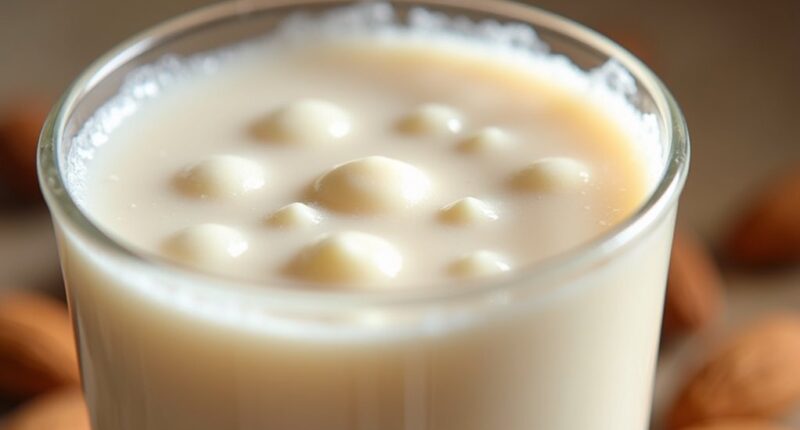If your almond milk’s looking chunky, don’t panic! It’s usually because of a few things like temperature, acidity, or even how it’s been stored. Heating it too much can make the proteins scramble like they’re in a race! Mixing with acidic stuff, like lemon juice, also causes curds to party. Plus, old almond milk just doesn’t want to be smooth anymore. Stick around, and I’ll share some tips to keep it silky and fresh!
At a Glance
- Almond milk can become chunky due to protein denaturation from excessive heating or shaking.
- Mixing almond milk with acidic ingredients like lemon juice leads to clumping of proteins.
- Poor grinding techniques result in larger almond particles that can clump together.
- Improper storage conditions, such as leaving opened cartons unrefrigerated, can cause spoilage and chunkiness.
- Using high-quality non-dairy creamers or stabilizers helps maintain a smooth texture in almond milk.
Causes of Almond Milk Chunkiness
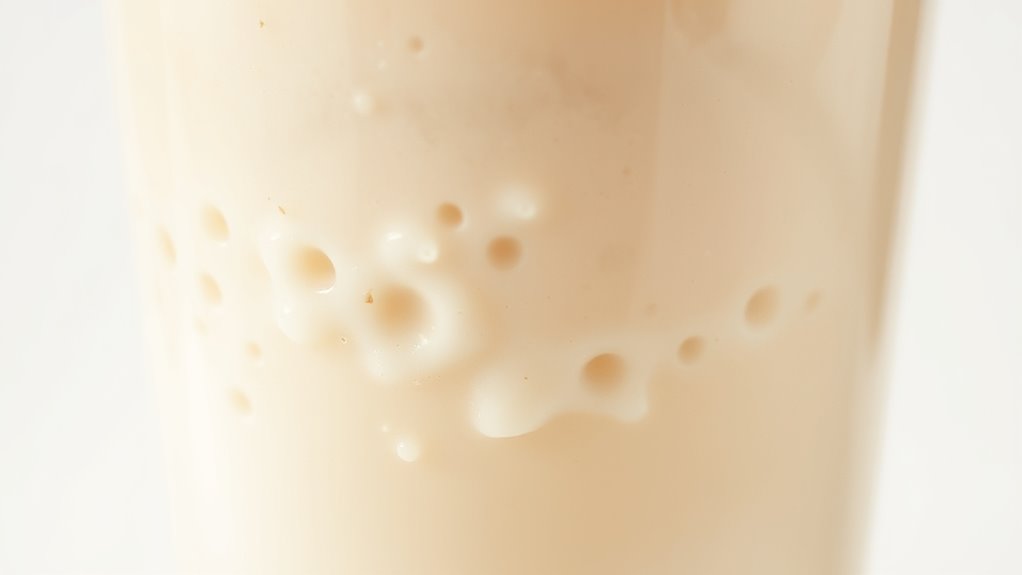
So, you’re wondering why your almond milk looks like it just got out of a wrestling match, right? Well, blame protein denaturation!
When almond milk gets heated or shaken too much, those plant proteins can unfold and clump together. Without the right emulsifiers—like those fancy additives in store-bought versions—it’s a recipe for chunky chaos.
Plus, if you mix in something acidic, like lemon juice, things get even crazier! The acidity can make proteins aggregate into visible curds. Additionally, using a high-quality non-dairy creamer can help maintain a smooth texture in your beverages.
The Role of Temperature in Almond Milk Curds
When you heat almond milk, you might be inviting a chunkiness party that nobody wants to attend! The temperature impact on almond milk is real, folks.
When you heat it too much, the proteins start to denature, causing them to clump together and ruin your creamy vibe. To keep that protein stability in check, try warming your almond milk gently before adding it to hot drinks.
Pour it in slowly, and don’t forget to whisk! Keeping temperatures below 65°C can save you from curdling chaos, making your drinks smooth and enjoyable—just the way we like them! Additionally, using the best milk replacement for your coffee can enhance the overall flavor and texture, making your morning brew even more delightful.
Influence of Acidity on Curdling
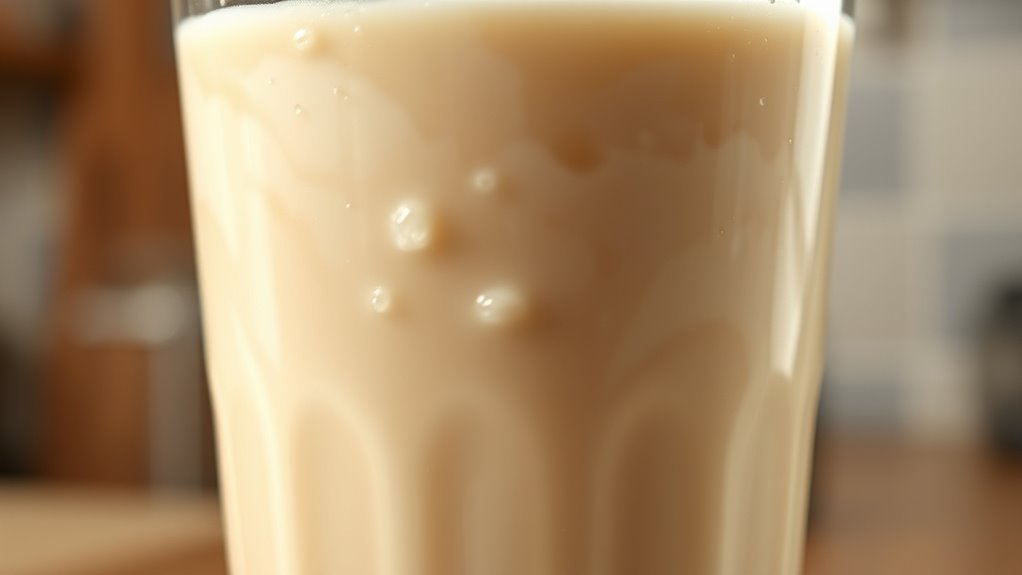
Heating almond milk can be a slippery slope, leading to those unwanted chunky surprises, but what about when you mix it with something acidic?
When you toss in that splash of coffee or a squeeze of lemon, you’re messing with the pH levels. Low pH can destabilize almond milk proteins, making them clump together like long-lost buddies at a reunion!
Strong acids, like lemon juice, can kick curdling into high gear, while coffee’s acidity can sneak in and do the same. The rich flavors of ground coffee can intensify this reaction, making it even more likely for almond milk to curdle.
Composition and Processing Factors
If you’ve ever wondered why your almond milk can turn chunky, you’re not alone! It all comes down to particle dispersion and how those almonds are ground. When almonds aren’t ground finely enough, you end up with larger particles that love to clump together, causing that pesky chunkiness. Different grinding methods, like wet versus dry grinding, also play a role in how smoothly everything mixes. Plus, if the almond milk isn’t properly homogenized, you might get some sad, separated solids. Additionally, the choice of storage container can affect the freshness of almond milk, which may lead to separation and chunkiness over time.
Storage and Shelf-Life Effects
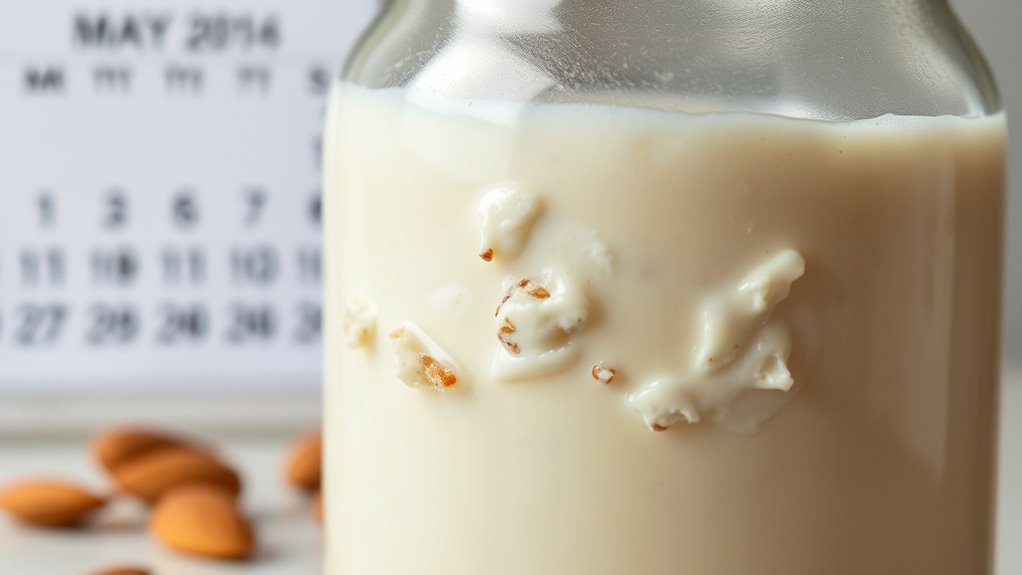
You might think you’ve got a handle on your almond milk’s smoothness, but the way you store it can totally throw a wrench in the works!
If you leave that unopened carton on a warm kitchen counter, it’ll spoil faster than you can say “chunky milk.” Unopened shelf-stable almond milk lasts about 1-2 months at room temperature, while opened almond milk needs a cozy spot in the fridge.
Remember, storage conditions matter!
Homemade almond milk? It’s got a short shelf life—only 3-7 days. So, keep it cool and tightly sealed to sip on smooth, creamy goodness for longer! Additionally, using eco-friendly coffee makers can help you maintain a sustainable kitchen environment while enjoying your beverages.
Prevention and Handling Tips
When it comes to keeping your almond milk smooth and creamy, a little prevention goes a long way!
Here are some handy tips to help you out:
Discover simple tips to ensure your almond milk stays smooth and creamy in every drink!
- Mix temperatures: Keep your almond milk and other liquids at similar temps before mixing.
- Quality selection: Choose brands with stabilizers for smoother textures.
- Gentle mixing techniques: Gradually add almond milk to your drink while stirring.
Additionally, consider using alternatives like coconut milk coffee creamer for a creamy texture that complements your beverages.
How to Identify Spoiled Almond Milk
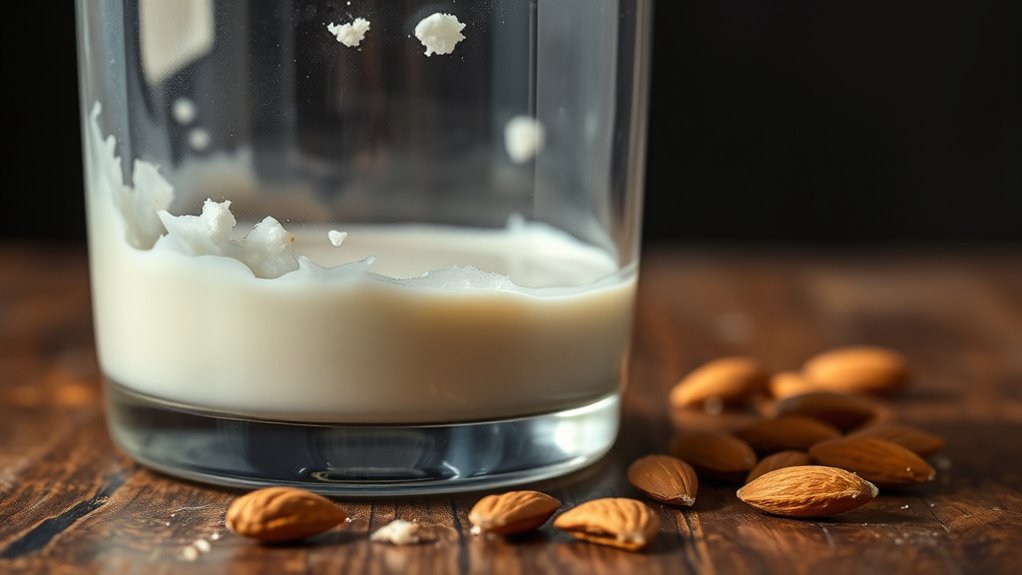
Spoiled almond milk can sneak up on you, especially when you’re craving that creamy goodness in your smoothie or coffee.
First, trust your senses! Look for spoilage indicators like clumps or odd textures; if it looks thick and chunky, it’s time to toss it.
Give it a sniff—if it smells sour or funky, don’t take a sip! You might even spot some black flecks or a swollen carton, which are big red flags.
Always do those sensory checks before pouring it into your favorite mug. If you’re a coffee lover, consider switching to affordable coffee choices that won’t disappoint when paired with almond milk.
When to Discard Almond Milk
Ever wondered when it’s time to say goodbye to that carton of almond milk in your fridge?
Here’s a quick guide to keep your taste buds safe:
Here’s a handy tip to ensure your almond milk is fresh and safe to enjoy!
- Check those expiration dates—opened almond milk should be tossed after 7 to 10 days.
- Look for spoilage signs like odd smells, curdling, or a strange texture.
- If it’s been left out for over two hours, it’s a no-go!
- Additionally, just as with coffee, high-quality materials can help extend the shelf life of almond milk containers.
